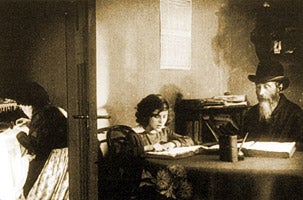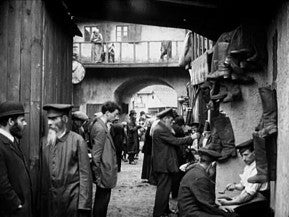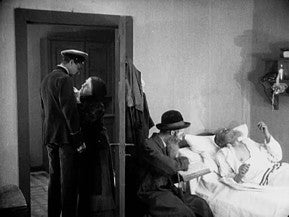Back in early October, I ran into Thomas C. Christensen, who is the Danish Filminstitut Curator in Copenhagen. He gave me a copy of their newest DVD/Blu-ray release, a double feature consisting of Love One Another (Die Gezeichneten, 1922) and The Bride of Glomdal (Glomdalsbruden, 1926), two previously “lost” films by the great Danish master Carl Theodor Dreyer. While Dreyer’s other well-known silent features—including Leaves From Satan’s Book (1921), Master of the House (1925) and The Passion of Joan of Arc (1928)—have long been available to film scholars in various formats, Dreyer’s fourth feature, Love One Another, was considered lost until 1960, when a nitrate print was found in Moscow.

Produced for a small, independent film company, Die Gezeichneten actually translates as “the stigmatized,” and refers to the Jewish people, experiencing pogroms in the Shtetl in Tsarist Russia around 1900, but also to all members of the Jewish faith subject to anti-Semitism. The film is based on a realist novel (1912) by the popular Danish writer Aage Madelung, and features another one of Dreyer’s strong female characters, which obviously drew him to the subject matter, as did the theme of human injustice and perseverance. In the late 1950s, Dreyer wrote an essay in which he identified the roots of anti-Semitism in the "Gospel of St. John" and the "Acts of the Apostles," both written at the end of the first century.

Surprisingly, given our hindsight view of the Holocaust, the early 1920s had seen a spate of Jewish-themed films appearing in Germany, including Judith Trachtenberg (1920), The Golem (1920), Nathan, the Wise (1922), The Old Law (1923), Good Luck (1923) and City Without Jews (1924). For his cast, Dreyer chose German and Russian actors, the latter recently exiled due to the Bolshevik Revolution. Supposedly, Dreyer preferred the Russians—including Polina Piekowskaja, Vladimir Gajdarov and Richard Boleslawski—because they guaranteed authenticity, as did the many Jewish refugees from Russia that he hired as extras, some of which had directly experienced pogroms. Dreyer travelled to Lublin, Poland with his set designer to see one of the largest Jewish ghettos in Europe, then recreated exterior sets in Berlin-Lankwitz. When the film opened in Berlin in February 1922, it received an excellent review in the Berlin trade paper Der Filmkurier.
The story centers on Hannah-Liebe, a Jewish girl growing up in a small Shtetl village in western Russia populated by serfs and Jews, both oppressed. When Hannah becomes the object of malicious gossip, she moves to St. Petersburg to find her brother, Jakov, who has converted to Christianity and has become a successful lawyer. However, both eventually return to their native village when their mother is on her death bed and are caught up in a deadly pogrom instigated by a Tsarist secret police spy posing as a poor Orthodox priest.

Interestingly, like many American films depicting Jewish life—His People (1925) with Rudolf Schildkraut comes to mind—Die Gezeichneten develops a subplot around assimilation into the mainstream and the danger of losing one’s Jewish identity by giving up the faith. In the film, Jakov is disowned by his father, marries into a Christian family, but eventually realizes his mistake; he nevertheless becomes a victim of the pogrom. Fifteen years before the notorious Nuremberg Race Laws of the Nazis, this film presciently states that conversion would not protect Jewish citizens from anti-Semitism, no matter how assimilated. Indeed, the film’s depiction of the extreme violence of a full-scale pogrom must have been as shocking then as it is even today.
Happily, the quality of the DVD is excellent, thanks to a fortuitous discovery. Back when the original nitrate print was found in Moscow, the Danes purchased a copy and intercut Danish intertitles. That print was available in Copenhagen for many years, but in the meantime the nitrate had disappeared. Then in 2005, the French film scholar Bernhard Eisenschitz found the original Soviet print in the French National film archives, allowing the Danish Filminstitut to do a complete digital restoration in 2007 (scanned at 2K), including adding new intertitles from Dreyer’s original script and the Swedish censorship records. The DVD includes Danish and English titles, making it understandable to an international audience.
Ironically, the Danish star portraying the anti-Semitic agitator Johannes Meyer became one of Adolf Hitler’s most faithful film directors, producing over 20 features during the Third Reich, including several propaganda epics.






 Mobile Navigation
Mobile Navigation


Comments